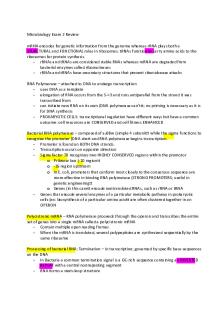Exam 4 Review - Summary Microbiology PDF

| Title | Exam 4 Review - Summary Microbiology |
|---|---|
| Course | Microbiology |
| Institution | University of Michigan |
| Pages | 2 |
| File Size | 28.8 KB |
| File Type | |
| Total Downloads | 108 |
| Total Views | 138 |
Summary
Exam 4 review guide...
Description
cells of the immune system: - cytokines/ chemokines= proteins that influence many aspects of immune cell differentiation - APC’s • macrophages - first defense cells that interact with a pathogen - abundant in many tissues • Dendritic cells - phagocytes that specialize in presenting antigen to lymphocytes - neutrophil • contains toxins or enzymes that are released to kill target cells - Lymphocytes • B Cells - originate in bone marrow - specialized APC’s and precursors of antibody producing Plasma cells - produce antibodies/ immunoglobulins (Igs) - B cell receptors (BCRs)= cell-surface antibodies on a B cell
- activated by Th2, B cells can differentiate into plasma cells which produce antibodies
- They can also differentiate into memory B cells which store the antigen for a secondary response where they differentiate into plasma cells
• T Cells - develop in bone marrow but mature in thymus - interact with particular antigens - T cell receptors (TCRs) = antigen-binding proteins of T cells
- Th1 cells recognize MHCII and stimulate cytokines which signal phagocytosis -
and more APCs Th2 cells attract B cells ThC cells recognize MCHI and stimulate cytokines and destroy the cell
bacterial pathogens - N. gonorrhoeae • binds to mucosal epithelial cells in the genitourinary tract, eye, rectum, and throat • cell surface protein Opa that binds specifically to host protein CD66 - Botulinum • uses AB toxin to block the presynaptic membranes of the stimulatory motor neurons blocking the release of acetylcholine • prevents muscle contraction - Cholera • B subunit targets the toxin specifically to the intestinal epithelium but has no toxicity itself • A subunit causes toxicity when it crosses the cytoplasmic membrane and activates the enzyme to convert ATP to cAMP which induces secretion of chloride and bicarbonate from small intestine epithelial cells into intestine lumen • secretion of large amounts of water - Diphtheria - TSS - S. Aureus
viral pathogens - influenza • targets lung mucosal cells and attaches specifically to lung epithelial cels by way of protein hemagglutinin (HA) present on the virus surface • caused by RNA virus • singles stranded RNA genome surrounded by an envelope- uses reverse transcriptase or RMA replicase • zoonotic - HIV...
Similar Free PDFs

Microbiology Exam 2 Review
- 14 Pages

General Microbiology Exam 3 Review
- 46 Pages

microbiology Exam
- 7 Pages

Summary - complete exam review
- 111 Pages

Summary - Final Exam Review
- 54 Pages

Summary - Final Exam Review
- 4 Pages

Summary - Chapter 4 review
- 1 Pages

Microbiology Test 2 Review
- 19 Pages

Anthropology Exam 4 Review
- 15 Pages

BIOL180 Exam 4 Review
- 4 Pages
Popular Institutions
- Tinajero National High School - Annex
- Politeknik Caltex Riau
- Yokohama City University
- SGT University
- University of Al-Qadisiyah
- Divine Word College of Vigan
- Techniek College Rotterdam
- Universidade de Santiago
- Universiti Teknologi MARA Cawangan Johor Kampus Pasir Gudang
- Poltekkes Kemenkes Yogyakarta
- Baguio City National High School
- Colegio san marcos
- preparatoria uno
- Centro de Bachillerato Tecnológico Industrial y de Servicios No. 107
- Dalian Maritime University
- Quang Trung Secondary School
- Colegio Tecnológico en Informática
- Corporación Regional de Educación Superior
- Grupo CEDVA
- Dar Al Uloom University
- Centro de Estudios Preuniversitarios de la Universidad Nacional de Ingeniería
- 上智大学
- Aakash International School, Nuna Majara
- San Felipe Neri Catholic School
- Kang Chiao International School - New Taipei City
- Misamis Occidental National High School
- Institución Educativa Escuela Normal Juan Ladrilleros
- Kolehiyo ng Pantukan
- Batanes State College
- Instituto Continental
- Sekolah Menengah Kejuruan Kesehatan Kaltara (Tarakan)
- Colegio de La Inmaculada Concepcion - Cebu





